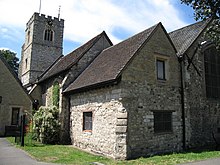St Margaret's Church, Barking
| St Margaret's Church, Barking | |
|---|---|
 |
|
| 51°32′7.89″N 0°4′33.6504″E / 51.5355250°N 0.076014000°ECoordinates: 51°32′7.89″N 0°4′33.6504″E / 51.5355250°N 0.076014000°E | |
| Location | Barking, Barking and Dagenham |
| Country | United Kingdom |
| Denomination | Church of England |
| Website | Church website |
| History | |
| Dedication | Margaret the Virgin |
| Events | 1215: Foundation 1762: Marriage of Captain James Cook to Elizabeth Batts |
| Architecture | |
| Status | Active |
| Functional status | Parish church |
| Heritage designation | Grade I listed |
| Administration | |
| Parish | Barking |
| Deanery | Barking |
| Archdeaconry | Archdeaconry of Barking |
| Episcopal area | Barking Episcopal Area |
| Diocese | Diocese of Chelmsford |
| Province | Province of Canterbury |
| Clergy | |
| Rector | The Rt Revd Trevor Mwamba |
| NSM(s) | The Revd Elwon John |
| Laity | |
| Reader(s) | Canon Pat Nappin |
| Organist(s) | Kyle Richardson |
| Churchwarden(s) | Gillian Gillespie, Dave Jarvis, Kunle Olaifa |
| Verger | Ron Wood, Joanne Wood |
| Youth ministry coordinator | Santou Beurklian-Carter |
St Margaret's Church or the Church of St Margaret of Antioch is a Church of England parish church in Barking, east London. The church is a grade I listed building and is dedicated to Margaret the Virgin.
It originated as a chapel for local people within the grounds of Barking Abbey, to the south of the Abbey church. Its oldest part is the chancel, built early in the 13th century during the reign of King John. The building is said to have been made into a parish church in 1300 by Anne de Vere, abbess of the Abbey. Until the 1390s Barking formed a rectory, held by the Abbey and divided into two vicarages known as 'Northstrete' (probably funded by income from the Ilford area) and 'Southstrete' (serving the Abbey church). The area suffered severe flooding in the late 14th century, leading to financial difficulties and a merger of the two vicarages from 1398 onwards A chaplain from the Abbey led worship. The present bell tower was added late in the 15th century.
It remained a parish church when the Abbey was dissolved and the rectory and advowson devolved to the Crown, who initially leased it to the widow Mary Blackenhall for 21 years in 1540. In 1557 these were bought by Robert Thomas and Andrew Salter using money from the estate of William Pownsett of nearby Loxford, and granted to All Souls College, Oxford, in return for the vicar praying for the souls of Pownsett, his parents and benefactors every Sunday, giving 6 shillings and 8 pence amongst twenty poor people annually on the anniversary of Pownsett's death, paying the College an annual sum to maintain two poor scholars and only being absent from the parish 80 or fewer days a year. The College presented when the next vacancy occurred in 1560, but at the following one the Crown contested its right, though this was overturned via a lawsuit. Sir John Petre reconfirmed the 1557 grant in 1594, but dropped the requirement to pray for the dead. The right is now shared between All Souls College, Oxford, the Bishop of Chelmsford (in whose diocese it now falls) and the church's churchwardens.
...
Wikipedia
